How to Fly a Spinnaker on a Cruising Catamaran
There doesn’t seem to be much written about spinnakers for cruising cats, so I thought I would put down a few insights that I have discovered from our limited experiences so far. I am by no means an expert, but perhaps that is a good thing, as these tips might be of help to other newbies to the spinnaker game.
On Life Part 2 we have an asymmetric kite, so I can’t say anything about either symmetrics, nor bowsprit-mounted screachers etc.
So, what have we learned?
First, make absolutely sure you get yourselves an ATN spinnaker sock. This makes life incredibly easy. The spinnaker lives inside the sock, you hoist up the sausage, and then you pull down on the blue rope, which raises the sock up the spinnaker to its head, thereby releasing the sail from the bag. Voila! You sail is flying nicely with no fuss or bother.
Actually, here are the exact steps:
First, set up the sheets and guys. We have a single sheet, and two guys, one to a block at the tip of each bow. You are going to hoist the spinnaker to leeward, so make sure that the sheets go around the outside of the shrouds and lifeline, and through the block way at the back before coming up to the winch. The guys, likewise go outside of everything (ie the forestay), through the blocks, and back to some winches. Attach the halyard to the head, again, making sure it is on the correct side of the forestay and outside (to leeward) of both jib sheets.
Tighten the guys to your guess of the correct position, but err on the loose side.
Tighten the sheet pretty much as much as you can.
Now hoist the sausage up to the top. It should go up under and to leeward of the jib sheets. Throughout all this it is very easy to manage as there is nothing flapping around. Once up, it just hangs there as a big sausage.
Now have someone on the sheet winch and, if available, someone on the the windward guy. As you hoist the ATN sock, have the crew member haul in the sheet. This ensures that it doesn’t get bunched up in the bag, nor twisted on its way out. By doing it this way the spinnaker will fill even as you are raising the sock. The person on the guy may need to bring his in too. As soon as the sock is up, you can then trim the guy and sheets correctly for the wind.
Finally, loosely tie off the sock uphaul so that the lines are under control for when you next need them. There is no need to tie it tightly as there is no way that the sock will come down by itself.
Dousing the sail is just the same procedure in reverse. You need one person on the sheet. As you start to pull down the sock, have them gradually release the sheet. Don’t do it all at once as the whole thing will be flapping crazily. On the other hand, if they don’t ease it enough you may have a job pulling the sock down. You will have the chute flapping somewhat, but it is quickly over, and very manageable. Tie up the downhaul and then lower the sausage into your bag or sail locker. Stuff the sheets, guys, and uphaul in last so that you can pull them out first when setting it up next time.
Trimming the Guys
By having two guys you can position the tack of the sail just where you want it, both laterally, and vertically. The closer you are to the wind, the closer it will be to the leeward hull, and also the lower it will be, so as to present a straighter, tighter luff. This will enable you to sail it much higher than you might expect! Ours will even pull nicely at 60 deg to the wind! Note, however, that even then, the tack is still to windward of the leeward hull yet, because of the downward pull of the leeward guy it is not flapping about way up in the air.
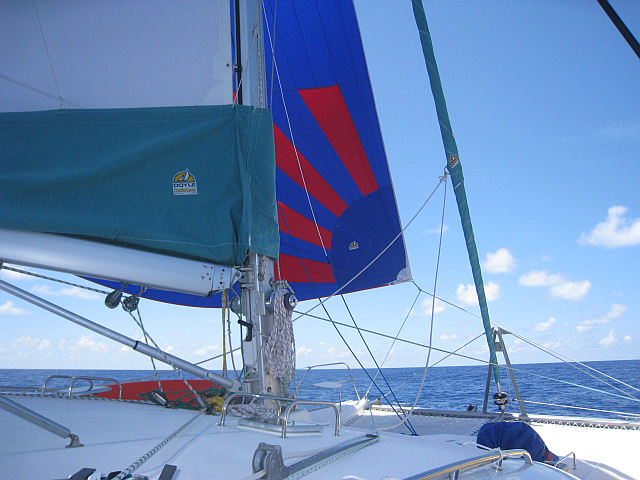
Spinnaker trimmed for beam reach using two guys forming a bridle from both bows to the tack of the sail
Downwind, of course, you bring the sail right over to the windward hull and let the tack rise up a bit to give a nice full bellied sail. Ease the sheet to allow some curvature in the luff. The sail should be trimmed so that the luff is just on the verge of curling in, then tighten the sheet just a little bit so you don’t have to be watching it all the time. Trimmed like this, in some consistent offshore winds, you can just leave it up for hours at a time with minimal attention. You will soon hear if it needs trimming!
Be careful you don’t over tension the sheet, as it will cut your speed down as much as a knot. On the other hand, on a dead run (or even a bit by the lee) don’t let the sail come right over to the windward side as it will then start to oscillate a lot. It will be much steadier, and just as fast, if you trim it a bit tighter and a bit more to leeward.
What About The Mainsail?
Just as the main will blanket your genoa, it will also blanket the spinnaker. Not only does it blanket it, it also sets up all sorts of horrible eddies around the back of the main. That means that with the wind after of about 120 deg you simply cannot fly them both. All that will happen is that the spinny will collapse and then, buffeted by the eddies, will get itself nicely wrapped around the forestay. Absolutely the last thing you want.
So, that means if you are going downwind, before you put up the kite, you will have to round up to windward and drop the main. If you keep up a little bit of jib, you can back the jib to get you back onto course, and then hoist the kite. You can hoist it up behind the jib, if you want the jib to give you some forward motion while you are doing all this. Then when the kite is ready to be un-socked, roll up the jib and away you go.
Across- or even up-wind, ie with the wind forward of 120 deg you can fly both – and you will get some great performance. Again, the trick here is to get the main up first, as you have to be head to wind for that, then bear away and hoist the spinnaker as per normal.
What if it All Goes Wrong?

This is what happens when the spinnaker gets tangled around the forestay. It may be impossible to untangle it without going up the mast.
Spinnakers are BIG sails, and can exert a LOT of force through those ropes that can all be thrashing about, so you need to take care.
So, what do you do if in a panic? You want to release all that force both safely, and in a way that will enable you to gain control of the sail. The last thing you need is for the sail to fall in the water and then get run over by the boat.
First, release the GUYS, not the sheet. Just let them fly. This is why you don’t put a stopper knot in the end of them. It doesn’t matter if a rope goes in the water (as long as your props aren’t turning). By releasing the tack of the sail, it will stream downwind from the clew. The clew is attached at the back of your boat. So that means the spinnaker will be over the boat. If, instead of the guys, you release the sheet, then the spinnaker will be streaming out from the front of the boat. If you then try to lower it from that point, you have a good chance of it coming down into the drink, instead of into the boat.
Now adjust your course so that you have the wind at about 120 to 150 deg off the bow. Why that angle? If you have the wind too far forward, then the spinnker will be flying off the side of the boat. Not easy to reach or manage. If you have the wind too far aft, then the kite will fly forward and, in its wild thrashing, wrap itself nicely around the forestay. Believe me, you don’t want that to happen!
With the wind on the quarter, the kite will be off your leeward bow. If you drop it too quickly, and it lands in the water, at least you won’t run over it. Nor will it be flapping around in your face, as it would if you were on a run.
Having done that, the next step is to douse it. Hopefully you have an ATN sock and it is working, in which case this is all very easy and, before you know it, the sail is under control and easily lowered onto the trampoline. If the ATN is stuck, which is perhaps why you are in this predicament, no worries. The goal at this point is to lower the sail while at the same time pulling it onboard by the sheet and then the leach. Do NOT attempt to pull in the guys, nor even try to bunch up the sale as it comes down. If it fills with wind it will just pull out of your hands. So, have one person on the sheet, and as many people as you can to manhandle the leach (and foot) of the sail as the person on the halyard slowly lowers it.
In fact, it is worth practicing the above procedure on a nice sunny day with a 10kt wind.
If it is really windy and the sail is just too much to handle, then you could try unfurling the jib and sheeting it in tight. This has two benefits and one drawback. First, it will blanket the spinnaker, making it easier to control. Second, it protects the forestay. You can’t wrap a spinnaker around the forestay when the jib is unfurled. Just impossible.
However, it does mean that you have to drop the spinnaker behind and under the jib. Not so easy. Make sure that you are wearing a harness if you attempt to do this. Also, don’t unfurl the genoa all the way. By releasing it just half, you keep the foot higher, making it easier to get under it.
So, to recap: let the guys fly, not the sheet. Steer a broad reach, not a run. Especially not a run if you have the main up. In fact, if the main is up you should probably be closer to a beam reach so as to make quite sure you don’t get that forestay wrapped.
Gybing
This is about cruising, not racing. Comfort and safety are the goals, not speed.
For that reason, here is how we gybe:
- We pull down the sock so the spinnaker is doused. But leave the sail hoisted. It is now hanging as a big sausage on the leeward side of the trampoline.
- We then take the sheet out of its current block and walk it around the front of the boat, outside the shrouds on the other side, and through the new block to the winch.
- The guys don’t need to be touched, as they are already going to two winches.
- Having done all that, we steer the boat through the gybe under bare poles (remember, the main is down, and the jib is furled). As we do so, we manhandle the sausage, and the downhaul ropes around the front of the forestay, so the sausage is now hanging on the new leeward side.
-
Now on the new tack, with the sausage set up to leeward, we sheet in on the new side and raise the sock. The spinnaker is now flying on the new tack.
As you can see, by doing it this way there is no chance of getting in a knot around the forestay. It all stays very calm and under full control. Easy.
Why Bother with a Spinnaker?
Very few cruisers use spinnakers. There seems to be a bit of fear about them which, in my mind, is unfounded.
Cats seem to operate best at 60 to 120 deg to the wind. They are not great upwind on a beat, nor are the great on a run. There are two reasons for this:
First, you can’t ease out the mainsail enough. Most cats have swept back stays. That means they get away with no backstay, which is nice. But it means that the shrouds get in the way of letting the boom out. Also, most cats seem to lack a decent boom vang. So you let the main out, and it just rises into the air, producing a whole lot of twist, which then puts your sail onto the stays even sooner.
So, you have to sheet the thing in, which is far from ideal when you are trying to catch the wind on a run.
Not only that, below about 120 deg to the wind, the main blankets the genoa or jib (as you have gathered, I use these terms pretty interchangeably even though, technically, they are different sails) , making it basically useless. So now you have to furl the jib, and keep the main sheeted in, or you drop the main and sail with just the genny. Both of which are pretty slow.
Then, on top of that, the genoa sheets are too far in-board so, like the main, you can’t ease out the sail far enough from the center line to catch more wind.
The traditional solution to this is to use a whisker pole to hold the genoa out to the side. Or, on a run, to hold it out on the opposite side to the main, so as to run wing-on-wing ( or goose-winged as we Brits call it). But that means you now have to carry and manhandle this long, big pole. And where are you going to store that? And you have to worry about an accidental gybe. Some people even carry two genoas, so they can drop the main and have two foresails poled out on opposite sides, wing-on-wing. But now you need not one, but two whisker poles.
Hmm. Seems to me much easier to use the spinnaker – and you get better performance. In fact, in as little as 5 knots of apparent wind we are making over 3 kts on a run with the kite up. Beats running the engine.
How Much Wind?
The spinnaker is a light wind sail. Ours seems to need about 4 kts to fly properly, and does well at 5 kts. I hate motoring, so my threshold for killing the engines is when we beat 3 kts over the ground. We will then carry it up to about 15 knots of apparent wind. At that point it is getting fairly windy, and it is a big sail. So at that point we will switch to the genoa with or without the main depending on our point of sailing, and will still maintain a decent speed. As I said, we are cruising, not racing, and also with just two of us on board we are also short handed.
So, that’s about it. Any questions, please do leave a comment below! Oh, and don’t forget to press the ‘Like’ button!

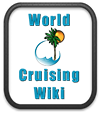




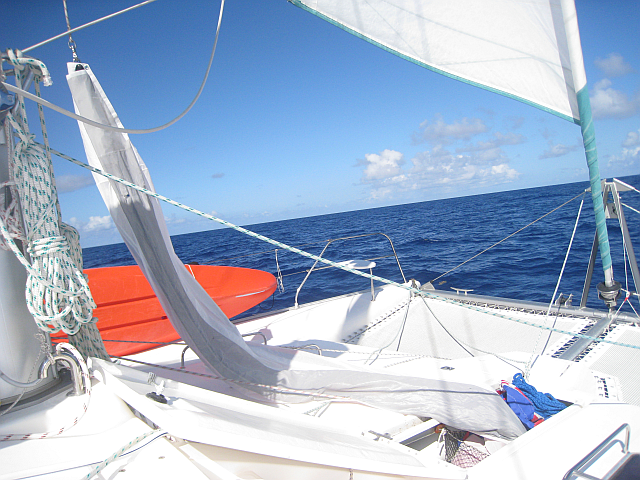
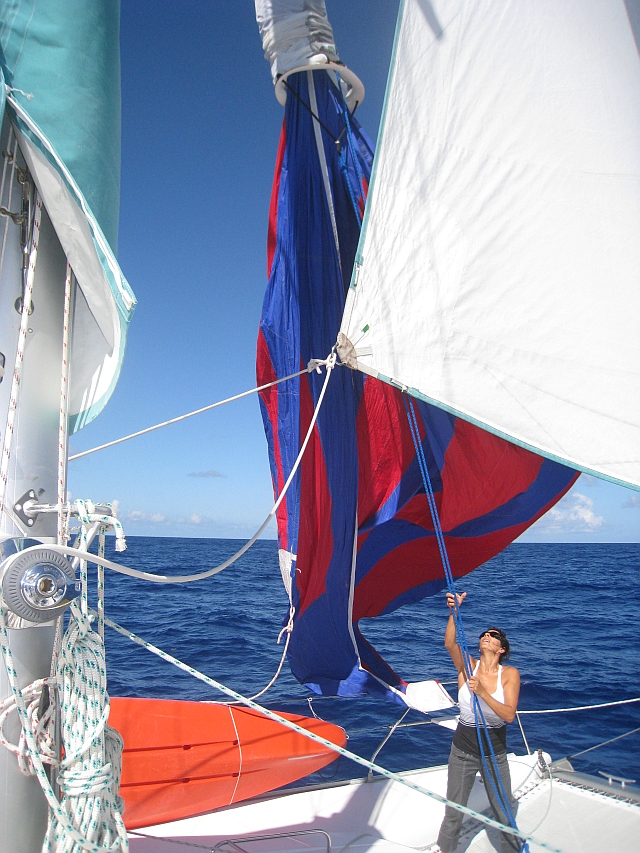
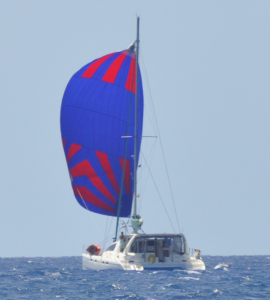
Wow! What a lot of technical stuff. Glad I don’t have to do it. Should be useful to many people. Nice photos.
LIke everything else, it is easy once you have practiced it a few times. Just the same as in dinghies, but bigger 🙂
Excellent article! My wife and I also own and cruise a Leopard 42 (hull #33) JAMU, and have been considering the addition of a cruising spinnaker. We’ve not used a spinnaker since our first sailboat, a monohull, many years ago when we had young sons to man the deck. Now as we cruise as a couple, our major concern is handling the deck operation by myself, as she has limited use of her arms and would remain at the helm. I’d appreciate (by email) if you have any additional rigging considerations or tips for shorthanded sailing.
Safe Sailing,
Joe Donnaway
s/v JAMU – Leopard 42
Hi Joe,
I guess the trick really would be to rig the boat for singlehanded sailing – which means having all the lines brought into the cockpit. Having said that, Ceu and I can manage all the deckwork with one person in the cockpit at the helm and the other on the deck. The only things we have to do forward are the reefing (we have slab reefing, and it is not brought back), and the spinnaker.
The problem with the spinnaker on the Leopard is that there is a shortage of winches in the cockpit, so we end up having to use one cockpit winch for the sheet, one for the lee guy, and then we take the windward guy to one of the winches on the mast. Not ideal. we have been debating putting a couple of extra winches next to the cockpit ones, sort of down the side of the coach roof, but haven’t done so yet.
Raising the spinnaker by yourself is doable. Pull the whole sock out onto the trampoline so it is all freed up, then hoist the sausage, then make sure your sheets and guys are set up. Then drop the sock, and go back to the cockpit to trim the sheets.
Dropping it would be a matter of letting the sheet or guy go and pulling down the sock. With no one to handle the sheet, it would involve a fair amount of sail flapping, but again is doable as one person. It is a light wind sail, so it should all be doable without too much drama. Just don’t go higher than maybe 12 kts.
Hope that helps. It certainly makes light wind sailing a lot more fun so I would recommend giving it a go!
Fair winds,
Noel
Thanks, Noel. The spinnaker is being built by Calvert Sails, and we’ll get good practice in Cancun Bay when we return to JAMU in January.
Hi Noel,
Now ordering my lines and hardware. With no toerail holes, where do you normally attach the block for the sheet?
Cheers,
Joe
Good question. Life Part 2 already had a pad eye on each bow for the guys and pretty far back on each hull for the sheets so that was pretty easy.
I guess the options are either to install pad eyes or else drill some holes in the toe rail, provided, of course, that the toe rail is through bolted and not just screwed on, as there can be some significant forces on it.
If you do drill through the deck to install new pad eyes, don’t forget that the correct way to do it is to drill a larger hole, then fill it with epoxy filler, and then drill a smaller hole in the epoxy. And of course use a backplate to spread the load. That way you don’t run the risk of water getting into your foam sandwich.
As a temporary measure I guess you could attach a block to the aft mooring cleat, as they are pretty strong!
Hmm, Cancun sounds nice. We are just about ready to leave the boat in Cartegena to go back to Canada for a winter of skiing. Have fun in the sun!
Noel
Noel and Ceu
Thanks for some interesting articles. Sounds like you have really taken up the challenge. Well done.
We are taking our R&C Leopard 4000 Catamaran off the Sunsail Fleet in BVI and sailing her to Cienfuego in Cuba this July/August 2012. Any general tips you can let us have on route, plans, obtaining charts, weather, hurricanes etc. etc. etc. would be appreciated.
We are sailing shorthanded also and need to complete in 3 weeks (but will leave her somewhere else if all goes wrong). We have just bought a good quality but second hand symetrical spinnaker. We plan to fly her during passage from the front of each pontoon controlled just by the sheets through winding blocks attached at the clews and running back into the cockpit (no guys or pole). We think the simplicity of this set up will work and as we will be going West with the Trades behind us it will mean long hours of running or broad reaching under light airs. Any comments would be appreciated.
Thanks
Andrew and Jane
Hi Andrew and Jane,
Congrats on taking the plunge!
We never made it to Cuba, though thought about it and would like to do it in the future, so keep us informed on your adventures there!
July and August is indeed Hurricane season, so do keep a close watch on the weather and make sure you have a good understanding of which way you should head if there is news of a storm approaching. See our Weather page for some info on getting weather updates.
Assuming you don’t have any storms you should, as you say, have a quiet downwind sail which should be very pleasant. Our trip from USVI to the Turks and Caicos was very straightforward. A visit to Dominican Republic would probably also be very pleasant. USVI is quite cheap for getting provisions, especially compared with Tortola!
A symmetrical spinnaker would normally want a pole, but on a run or broad reach you can probably do it by taking the windward sheet down to the windward bow, but I would think you will still want to take the leeward sheet farther aft so that you have a bit more control over it. You will have to experiment with the best position fore and aft to place the block before going to the winch. Find a nice quite day with no more than 5 kts apparent and play around with it to see what works. And make sure you have a good system for getting it down in a hurry!
One thing I have heard about Cuba is to have a printed sheet pre-prepared that lists ALL the details of your boat and crew (and I mean eye color, hair color etc etc) so you can just hand the sheet to the countless officials that will come aboard at each port.
What is your plan after that? Keep going west to Central America? If you are planning to return East, make sure you read The Gentleman’s Guide to Passages South otherwise you will be thrashing and bashing to windward which will be no fun at all. And allow enough time for the passage too.
Fair winds!
Noel & Ceu
Hi Andrew and Jane
Just been speaking with Roger from Burned Out. He uses a symmetrical spinnaker on his cat. He does use a pole. But on a dead run, he also flies it without a pole.
He does this by attaching two lines to each corner. One from each corner goes down to its bow below. This stops the kite from ballooning up into the sky.
The other line from each corner goes aft as sheet.
With the four lines like that he is able to control its shape and set pretty well.
Hope that helps!
Noel
Noel,
Nice and complete description of spinnaker sailing. We do it exactly the same except with a bow sprit. Do you always haul your spin halyard all the way up? I usually have about 5′ of halyard out (haven’t tried it tight).
We will be in the Adriatic next year. Where are you sailing then?
Hi David
Yes, we hoist it to the top.
Next year: two possibilities, haven’t decided yet.
a) We might do the East Med Yacht Rally
b) We might do the Adriatic – Croatia and up to Venice
Or maybe we will do A) followed by b)
I expect after that we will head for the Canaries and then across the pond back to the Caribbean and Central America.
But who knows? We will find out next year. 🙂
Noel
Noel,
On your Leopard, you attach the guys to the clew of the sail, then through blocks on the bows back to the winches. I’m assuming you are leading these back to the jib/main sail winches on the cabin top? If so, which winch do you lead the sheet to? It seems like you are out of winches.
Thanks,
Eric
We are out of winches, almost. Which is why I just bought a couple more of the 40ST to put next to the big ones to make things easier.
What we do at present is to use the two big ones on the cabin roof, plus the little one that serves the traveller. That works if we don’t have the main up. If we do, then we use the winches on the mast.
Not ideal, which is why we are fitting some more winches.
Noel
Noel,
We ended up leading the guys from the blocks on the hulls back to the winches on the mast (Leopard 47). Works great!
Thanks,
Eric
Thanks for this primer- very helpful. Have you fitted your extra winches? If so, it would be great if you could share some pictures showing where you mounted them.
Thanks,
Steve
Just bought them. Planning to have them installed in the next month or two. Will indeed post pictures when we do.
Thank you so much for the detailed instruction on flying a spinnaker .. I’m a relatively new sailor and have a FP Belize 43 which I love sailing but am now in SE ASIA with relatively low winds .. After making the passage in SE TRADES from Cairns Australia to Bali , I am now planning a northerly voyage towards Thailand . I believe I will need these great sailing tips to enjoy the kite I have .. Am looking fwd to seeing my colourful kite up and Feeling confident with trimming after following advice and practice 🙂 I hope that you are finding favour with the seas and winds , cheers , Paul
It seems to me you can’t be that new of a sailor if you are making passages like those already! Enjoy the sailing and congrats on joining the lifestyle!
Noel
Thanks for the great article! Most of the stuff written on asymm spinnakers are for racing monohulls, not cruising catamarans, so this was appreciated! We are in a Leopard 48 in Gran Canaria at the moment, waiting for the trades to show up so we can do our crossing to Barbados. Maybe we’ll meet up sometime! We have a new asymmetrical spinny as well that we had designed to handle a near-run that we anticipate using a lot on the crossing. My husband likes to fly it without the main up when we broad reach. My question is: How do you manage nighttime squalls? Do you just take the asymm down every night, or do you keep it up with a plan to quickly release the guy (or sheets?)
Hi Melinda,
We are currently in Mindelo, planning to set off for Barbados in about a week, so we might well see you here, or there! The trades seem to be well established here at the moment.
With just two or three of us onboard we don’t fly the kite at night. It is too tricky going up to the foredeck in the dark, and especially if the reason from bringing it down is because the wind just got up! Since we are in cruising mode we are not in a rush and would rather be comfortable and safe than sailing flat out.
Without the main up, sailing broad or on a run is dead easy – and minimal worries about accidental gybes!
Fair winds for your crossing, and perhaps we shall meet soon!
Noel
Hi great article. I have always had faster performance cats now an ocean cat 49 I rely on the schreecher set on the bowsprit as we are able to push the wind forward in light airs. Looking at asyms for angles greater than say 100. in previous boats I flew the asym from bowsprit and occasionally tacked to windward bow for deeper angles. But for this boat I have been considering guys like you use. I am wondering how to measure for the asym. Since it is a faster boat I would normally think 1.03 or so of the hoist length to keep the luff flatter and maybe 180% of the 24 foot beam for the foot. Would this still apply to this set up i.e. 1.03 of the hoist measured from the bow tack to the hoist point Any guidance would be appreciated
Phil
HI Phil
Sorry, but I really don’t know anything about measuring sails up – I would just give your measurements to the sailmaker and seek their advice.
Noel
Thankyou for this article, i’m Surprised I haven’t stumbled upon this before. We’re on a Lagoon 421 and have a symmetric on order and am looking for rigging info like this. We’re also short on winches.
Enjoy your spinnaker when it arrives. It provides a nice boost in speed when the conditions are right
Thank you so much for this very informative post. This winter I sewed up an asymmetrical plus sock from SailRite kits for the James Wharram designed Mana 24 catamaran I built the previous winter. Rigging for the new sail has been on my mind all winter but with your instructions it now looks mike it will be much easier than I thought. The Mana is a cat ketch, so no forestay or job/genoa to worry about. I like the idea of two guys, one to each bow, and one sheet to be switched from one side to the other when gybing. Again, thank you very much.
Good luck, Rod, with your new boat and set up. Hope you get lots of sailing in.
Noel
Great information and excellent explanation! We keep our Gemini 105Mc in Deltaville, VA and sail her like a ‘beach cat’ with benefits. This season we fabricated/installed a simple Barber-Haul that really improved beam/broad reach with our Genoa. An asymmetrical spinnaker will truly enhance our experience on Chesapeake Bay. Thanks!! FJ Viola
Gday guys,remember us……Tony and Sally ex Ron Glas!
We are now back on two hulls…where we belong….cruising the east African coast having had amazing adventures getting Ron Glas to Kenya.
Obviously Covid is seriously restricting the cruising and we are currently anchored up in Tanzania waiting till some other country allows us to visit
Came upon you looking for info on setting up our spinnaker!
Do keep in touch ,love Tony and Sally s/v Twende
Thank you for a well-written, descriptive article.
We sailed an Outremer 55L for years but had to give it up as it became too much boat for us as we got older. However, we cannot stay off the water; so are buying a Gemini Legacy. We realize it is neither a real cat nor a speed demon. We are going to an asymmetrical to try to get some speed and your article was a very well written refresher.
Thank you.